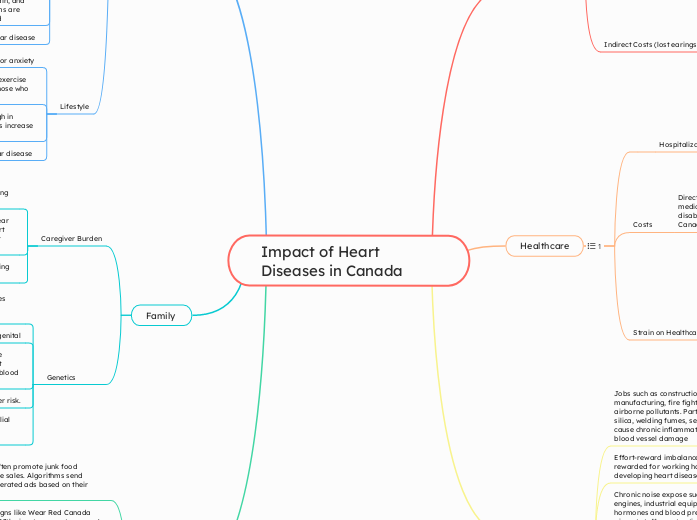Impact of Heart Diseases in Canada
Economy
Heart disease is the most costly disease in Canada. It costs our economy approximately $21.2 billion per year in direct and indirect costs.
Direct Healthcare Costs
Physician services constitute 12% of direct costs
Hospitalizations account for about 61% of direct costs
Medications make up 26% of direct costs
Indirect Costs (lost earings)
Premature mortality leads to losses of approximately $9.5 billion annually
Long-term disability results in costs around $3.6 billion
Short-term disability adds about $290 million to the economic burden
Healthcare
Hospitalizations and Readmissions
Heart disease is the leading cause of hospital admissions in Canada
There were over 421,000 hospital admissions for heart failure
40% of patients are readmitted at least once. This puts pressure on hospital resources and increases wait times for other patients
Costs
Direct costs (hospitalizations, surgeries, medications) and indirect costs (lost productivity, disability, and premature death) costs the Canadian healthcare system billions annually
Strain on Healthcare Services
The management of heart disease requires a wide range of professionals: cardiologists, family doctors, nurses, physiotherapists, dietitians, mental health providers, and social workers. This increases demand for specialized care and stretches human and financial resources across Canada
Heavy demand on community health programs, rehab centers, and personal support workers to help with long-term disability associated with heart disease
Understaffed hospitals
Occupation
Jobs such as construction, mining, transportation, manufacturing, fire fighting expose workers to airborne pollutants. Particulate matter, diesel dust, silica, welding fumes, secondhand smoke, solvents cause chronic inflammation, oxidative stress, and blood vessel damage
Effort-reward imbalance; individuals who are not rewarded for working hard have a higher risk of developing heart disease
Chronic noise expose such as loud machinery, engines, industrial equipment elevate stress hormones and blood pressure. Jobs include: airport staff, construction workers, factory workers, military
Shift work and night shifts disrupts circadian rhythms, sleep quality, metabolism and increases hypertension Shift workers are at a 21% increased risk of developing hypertension
Working 55 hours or more per week is associated with a 17% higher risk of dying from ischemic heart disease
Individual
Men
Tend to develop heart diseases in their 40s-50s'
Chest pain is a dominant symptom
More likely to have classic obstructive coronary artery disease
In 2023, 7.9% of Canadian men 18 and older reported having a heart disease
Men are more likely to die from heart attacks
Women
Women tend to develop cardiovascular diseases later in life. 7-10 years after men
Risks of developing a heart disease rise for women after menopause. This is due to a drop in protective estrogen
As of 2023, 4.7% of Canadian women aged 18 and older reported having heart disease
More than any other disease, heart disease is the leading cause of death for women. by 2004, 50.5% of all cardiovascular deaths occurred in women. Women are more likely to die from heart failure and stroke
Women experience atypical symptoms: fatigue, nausea shortness of breath, neck/jaw pain, and back pain. As a result, women's symptoms are often under-recognized or misdiagnosed
More likely to have microvascular disease
Lifestyle
Chronic stress or anxiety
Alcohol abuse, smoking, poor diet, poor exercise can trigger heart diseases especially in those who have poor genetics
Westernized diets increase risks. Diets high in sodium, saturated fats, and added sugars increase risks
1 in 3 people will develop a cardiovascular disease
Family
Caregiver Burden
Managing doctors visits and follow ups. Monotoring schedules and warning signs. Helping with daily tasks (bathing, cooking)
Depression and anxiety due to the condition. Fear of unknown. 20-50% of family caregivers report psychological distress when supporting a heart disease patient
Increased spending on home adjustments (railing ramps, hiring personal support workers)
Genetics
polygenic risk scores (many small-effect genes combined) contribute to the likelihood of developing heart disease
Congenital
Hypertension
Having a family member with a heart disease increases the likelihood of developing a heart disease. For example; genes that cause high-blood pressure increase the risks.
Africans and South Asians are at a higher risk.
Genetcially passed down conditions like familial Hypercholesterolemia and Type 2 Diabetes significantly increase risks.
Media
Tv ads in Canada often promote junk food consumption to drive sales. Algorithms send individuals user generated ads based on their cravings
Educational campaigns like Wear Red Canada Day. Held February 13th aims to promote women's heart health. CTV News and Global News cover the campaign, highlighting the research and impact
Lack of comprehensive health education in media. 1 in 3 Canadians do not understand the difference between a heart attack and cardiac arrest, nor are they aware of the distinct signs of heart disease in women
Media is accessible in Canada. Anyone has the power to search up, post and learn about heart diseases. TikTok, news channels, youtube, twitter, etc
